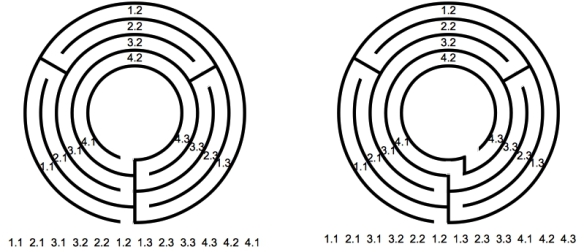At the end of the last post (see related posts) we were left with the following problem. If we number the segments consecutively, we obtain a unique seqence of segments. However it can not be directly seen in the sequence of segments which circuit is encountered by the pathway. If we number the segments by circuits, the sequence does indicate which circuit is encountered. However it then looses the uniqueness.
Now there is a possibility to combine the numbering. That means to write a number for the circuit first, then a separator and then a number for the segment. In the example of the labyrinth by Valturius this looks as follows (fig. 1).
The labyrinth has four circuits and three arms, and thus also three segments per circuit. The first number indicates the circuit, the second indicates the segment. This numbering provides some kind of coordinates for the various segments.
Let us now write the sequences of segments for the alternating and non-alternating labyrinths from the last post using this numbering.
Both variants have their own unique sequences of segments. In each element of the sequence of segments it can be identified which circuit and which segment is encountered by the path. Such a sequence of segments can be easily generated and memorized. A shortcoming of this numbering is that each element is composed of two figures and a separator. Furthermore the elements must be clearly separated from each other. Therefore this sequence of numbers requires more digits and more space.
Related posts:



Pingback: Sequence of Circuits – Conclusion | blogmymaze
Pingback: Sequence of Segments in One-arm Labyrinths | blogmymaze